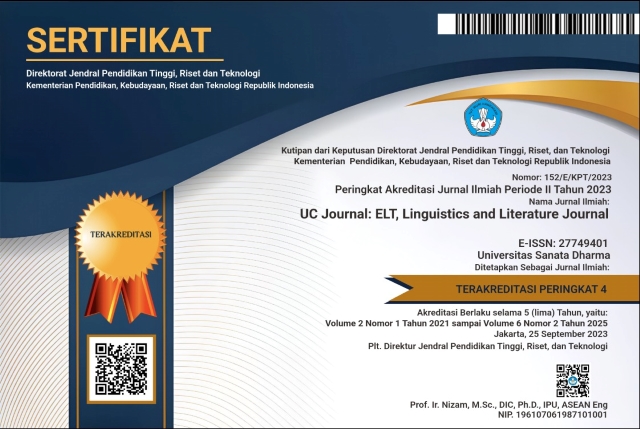WOMEN'S LANGUAGE FEATURES OF EILIS LACEY IN THE BROOKLYN MOVIE SCRIP
(1) Independent Contributor, Yogyakarta
(*) Corresponding Author
Abstract
Keywords
Full Text:
PDFReferences
Aini, L. M. (2016). Women language used by the main characters of Mockingjay movie. Retrieved on August 13th, 2017, from http://etheses.uin-malang.ac.id/3910/1/12320038.pdf
Chafetz, J. S. (2006). Handbook of the sociology of gender. New York: Springer.
Cheshire, J. (2003). Sex and gender in variationist research. In J. K. Chambers, P. Trudgill, & N. Schilling-Estes, (Eds.), The handbook of language variation and change, (pp. 423-443). Retrieved on September 25th, 2017, from http://en.bookfi.net/book/1206094
Coates, J. (1986). Women, men, and language. Retrieved on September 25th, 2017, from https://www.researchgate.net/file.PostFileLoader.html?id=585a3d30217e2019bd148321&assetKey=AS%3A441649743568897%401482308912555
Eliasoph, N. (1987). Politeness, power, and womens language: Rethinking study in language and gender. Berkeley Journal of Sociology, 32, 79-103. Retrieved on September 17th, 2017, from http://www.jstor.org/stable/41035360
Flick, U., Kardorff, E.V., & Steinke, I. (Eds.). (2004). What is qualitative research? An introduction to the field. A Companion to Qualitative Research, 5 (Jenner, B, Trans.). Retrieved on September 10th, 2017, from http://en.bookfi.net/book/1270445
Holmes, J. (2001). An introduction to sociolinguistics (2nd ed.). London: Longman.
Holmes, J. (2013). An introduction to sociolinguistics (4th ed.). New York: Routledge.
Jakobsson, S. (2010). A study of female language features in same-sex conversation. Retrieved on December 13th, 2017, from http://www.divaportal.org/smash/get/diva2%3A375135/FULLTEXT01.pdf
Lakoff, R. (1973). Language and womans place. Language in Society, 2(1), 45-80. Retrieved on September 17th, 2017, from http://www.jstor.org/stable/4166707
Lakoff, R. (1975). Language and womans place. New York: Harper Colophon.
Safitri, A.W. (2017). Womens language in Tangled movie: A sociolinguistic study. Retrieved on June 4th, 2018, from http://journal.student.uny.ac.id/ojs/index.php/quill/article/viewFile/6362/6142
Sunderland, J. (2006). Language and gender: An advanced resource book. Retrieved on September 25th, 2017, from http://en.bookfi.net/book/1161647
Sutanto, D. N. (2015). Feminist refiguring of La Malinche in Sandra Cisneros never marry a Mexican. LLT Journal: A Journal on Language and Language Teaching, 18(1), 1-8. Retrieved on December 13th, 2017, from http://e-journal.usd.ac.id/index.php/LLT/article/view/248
Vanderstoep, S. W. & Johnston, D. D. (2009). Research method for everyday life. San Francisco: Jossey-Bass.
Wardhaugh, R. (2006). An introduction to sociolinguistics (5th ed.). Oxford: Blackwell Publishing.
Yulia, M. F. & Permatasari, S. N. (2013). An analysis on the language style of the utterances in Magnum advertisements. LLT Journal: A Journal on Language and Language Teaching, 16(1), 1-10. Retrieved on December 13th, 2017, from http://e-journal.usd.ac.id/index.php/LLT/article/view/280
DOI: https://doi.org/10.24071/uc.v1i1.2849
Refbacks
- There are currently no refbacks.
Copyright (c) 2020 Sekar Lantik Pamikat

This work is licensed under a Creative Commons Attribution-ShareAlike 4.0 International License.
UC Journal is indexed in:
UC Journal Sinta 4 Certificate (S4 = Level 4)
We would like to inform you that UC Journal: ELT, Linguistics and Literature Journal, or UC Journal has been nationally accredited Sinta 4 by the Ministry of Education, Culture, Research and Technology of the Republic of Indonesia based on the decree No. Surat Keputusan 152/E/KPT/2023. Validity for 5 years: Vol 2 No 1, 2021 till Vol 6 No 2, 2025
DOI: https://doi.org/10.24071/uc
e-ISSN (validity starting Vol 1, No 2, November 2020): 2774-9401

This work is licensed under CC BY-SA.
Creative Commons Attribution-ShareAlike 4.0 International License
 UC Journal: ELT, Linguistics and Literature Journal, a scientific peer-reviewed journal, was established in 20 May 2020 and is published twice a year, namely in May and November, by the English Language Education Study Programme (S1/Sarjana PBI) in collaboration with the English Education Master's Programme (S2/Magister PBI) of Sanata Dharma University, Yogyakarta, Indonesia.
UC Journal: ELT, Linguistics and Literature Journal, a scientific peer-reviewed journal, was established in 20 May 2020 and is published twice a year, namely in May and November, by the English Language Education Study Programme (S1/Sarjana PBI) in collaboration with the English Education Master's Programme (S2/Magister PBI) of Sanata Dharma University, Yogyakarta, Indonesia.














